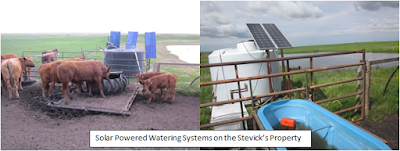Pincher Creek Voice
Monday, September 19, 2016
 |
| Quentin Stevick |
Quentin Stevick / Oldman Watershed Council blog – When I heard that our provincial government was interested in Green Energy, Anne and I got all excited. I have been using portable solar powered water systems since about 2002 to pump water from surface locations to our cattle to provide them with clean, fresh water and to prevent pollution of water bodies by these same livestock. I have learned many things: one of which is “Energy free does not mean labour and maintenance free”.
I felt the next step would be solar power for our ranch. The following information is current to mid April 201
I have a quote from a local contractor to install a 10.4 kW grid tied, roof mounted array of 40 X 260 watt solar panels. I already have an East-West orientated building which would be ideal for the project. The quote to me is $32,800.00 plus GST.
The most recent power bills I have are the complete year Dec. 15/2014 to Dec. 15/2015. Our total bill was $2823.84. We used a total 11,307 kW for this year. The actual power cost was $904.56 or approximately 32% of the bill. Anne gave me a link to Growing Forward 2 and I contacted Kelly Lunn and received the following reply. “Any electricity exported from a Micro Generator will only be used to credit against the electricity consumption at the meter; none will be applied to distribution (line) charges. Any electricity that you produce that you can use for farm loads at the time it is produced will reduce imported electricity, so will reduce the (relatively small) variable portion of Transmission and Distribution”. As of May 23/2016 Growing Forward 2 is not accepting applications.
My take-away is this:
When we were in Germany visiting one of my former students at her farm near Fulda, she was constructing a new barn and installing solar panels on it. The program available to her would generate approximately 12% return on investment.
I believe the following:
- The electricity providers should be required to accept enough electricity on an annual basis to off set total charges (in our case about $2900/year) not just the approximate $900 under the current regulations.
- A cap should be placed on the maximum power that could be generated so we do not have solar “farms” created that would cause the same blight on our landscape the wind farms create with their large foot print which fragments the land with roads and transmission lines.
- Individual houses and apartment buildings should be allowed the same advantages and access to the grid as farms so we can lower the reliance on fossil fuels.
The Alberta government is seeking public input on the new Energy Efficiency Alberta agency. Stakeholders, Indigenous communities and interested Albertans are being asked how to best promote energy efficiency and community energy systems across Alberta. An open house was recently hosted in Lethbridge where you could speak to panel members and technical experts. We encourage you to participate in the Energy Efficiency Alberta consultation before September 30, 2016. Click here to share your thoughts and ideas. Click
